
NGC 5821 is a spiral galaxy with a ring structure in the constellation Boötes. It lies near a similarly massed galaxy, NGC 5820, at the same redshift. Both galaxies were discovered by the astronomer William Herschel.

NGC 5613 is a lenticular galaxy in the constellation Boötes. It is part of the Arp 178 set of interacting galaxies, with NGC 5615 and NGC 5614.

NGC 5755 is a barred spiral galaxy in the constellation Boötes, member of Arp 297 interacting galaxies group of four: NGC 5752, NGC 5753, NGC 5754, and NGC 5755.
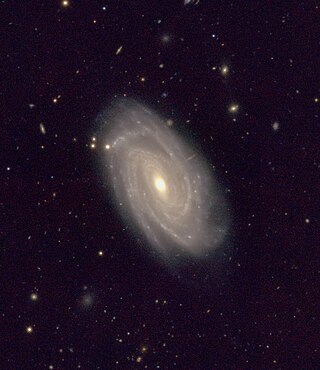
NGC 10 is a spiral galaxy located in the southern constellation of Sculptor. It was discovered by John Herschel on 25 September 1834. The galaxy is located at a distance of 346 Mly from the Sun. Its morphological classification in the De Vaucouleurs system is SAB(rs)bc, where the 'SAB' denotes a weak-barred spiral, '(rs)' indicates a slight ring-like structure, and 'bc' means the spiral arms are moderately to loosely wound. Paturel et al. (2003) assigned this galaxy a classification of SBbc, indicating a barred spiral galaxy.

NGC 24 is a spiral galaxy in the southern constellation of Sculptor, about 23.8 megalight-years distant from the Milky Way. It was discovered by British astronomer William Herschel in 1785, and measures some 40,000 light-years across. The general shape of this galaxy is specified by its morphological classification of SA(s)c, which indicates it is an unbarred spiral with no ring-like structure and moderate to loosely-wound spiral arms. This galaxy is positioned in the vicinity of the Sculptor Group, but is actually a background object that is more than three times as distant. It may form a pair with another background galaxy, NGC 45.
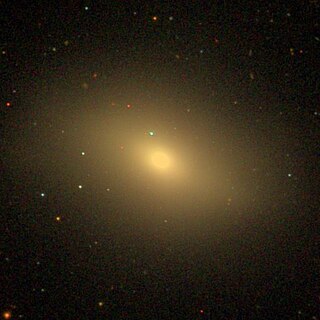
NGC 584 is an elliptical galaxy in the constellation Cetus. The galaxy was discovered on 10 September 1785 by the German-British astronomer William Herschel.

NGC 352 is a barred spiral galaxy in the constellation Cetus. It was discovered on September 20, 1784 by William Herschel. It was described as "pretty faint, small, irregularly extended" by John Louis Emil Dreyer, the compiler of the New General Catalogue; he also noted an "8th magnitude star 97 seconds of time to east" relative to the galaxy.

NGC 98 is a barred spiral galaxy in the Phoenix constellation. The galaxy NGC 98 was discovered on September 6, 1834, by the British astronomer John Frederick William Herschel.

NGC 90 is an interacting spiral galaxy estimated to be about 300 million light-years away in the constellation of Andromeda. It was discovered by R. J. Mitchell in 1854 and its apparent magnitude is 13.7. The galaxy is currently interacting with NGC 93 and exhibits two highly elongated and distorted spiral arms with bright blue star clusters indicative of star formation, likely caused by the interaction with its neighbor.

NGC 106 is a lenticular galaxy estimated to be about 270 million light-years away in the constellation of Pisces. It was discovered by Francis Leavenworth in 1886 and its apparent magnitude is 14.5.
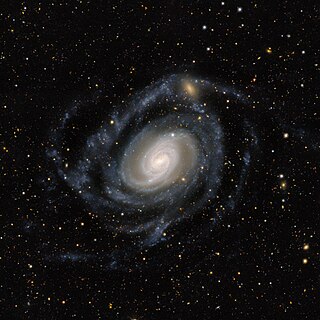
NGC 289 is a spiral galaxy in the southern constellation of Sculptor, located at a distance of 76 megalight-years from the Milky Way. It was discovered on September 27, 1834, by John Herschel. The compiler of the New General Catalogue, John Louis Emil Dreyer, noted that NGC 289 was "pretty bright, large, extended, between 2 considerably bright stars". The plane of the galaxy is inclined by an angle of 45° to the line of sight from the Earth.

NGC 6052 is a pair of galaxies in the constellation of Hercules. It was discovered on 11 June 1784 by William Herschel. It was described as "faint, pretty large, irregularly round" by John Louis Emil Dreyer, the compiler of the New General Catalogue.
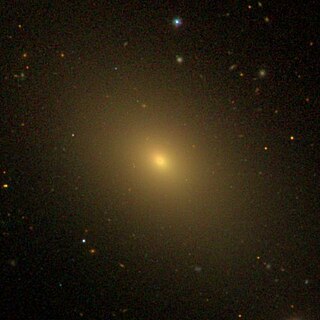
NGC 533 is an elliptical galaxy in the constellation Cetus. It was discovered on October 8, 1785, by William Herschel. It was described as "pretty bright, pretty large, round, gradually brighter middle" by John Louis Emil Dreyer, the compiler of the New General Catalogue.
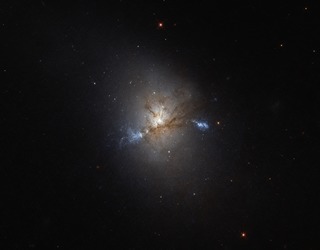
NGC 1222 is an early-type lenticular galaxy located in the constellation of Eridanus. The galaxy was discovered on 5 December 1883 by the French astronomer Édouard Stephan. John Louis Emil Dreyer, the compiler of the New General Catalogue, described it as a "pretty faint, small, round nebula" and noted the presence of a "very faint star" superposed on the galaxy.

NGC 3921 is an interacting galaxy in the northern constellation of Ursa Major. Estimates using redshift put it at about 59 million light years from Earth. It was discovered on 14 April 1789 by William Herschel, and was described as "pretty faint, small, round" by John Louis Emil Dreyer, the compiler of the New General Catalogue.
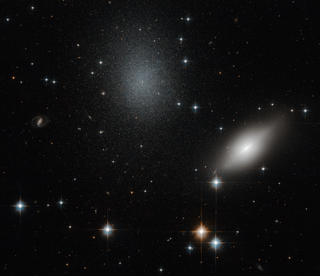
NGC 5011 is an elliptical galaxy in the constellation of Centaurus. It was discovered on 3 June 1834 by John Herschel. It was described as "pretty bright, considerably small, round, among 4 stars" by John Louis Emil Dreyer, the compiler of the New General Catalogue.

NGC 1077 is a spiral galaxy in the constellation Perseus. It was discovered on 16 August 1886 by Lewis A. Swift. It was described as "very faint, pretty large, extended" by John Louis Emil Dreyer, the compiler of the New General Catalogue.

NGC 485, also commonly referred to as PGC 4921 or GC 270, is a spiral galaxy in the constellation Pisces. It is located approximately 86 million light-years from Earth and was discovered on January 8, 1828 by astronomer William Herschel. It was later also observed by Heinrich d'Arrest and Herman Schultz. When NGC 485 was originally categorized in the New General Catalogue by John Louis Eil Dreyer in 1888, it was incorrectly described as a "considerably faint, pretty large, round, 8th magnitude star 3 1/2 arcmin to southwest".

NGC 834 is a spiral galaxy located in the Andromeda constellation. It is estimated to be 160 million light-years away from the Milky Way galaxy and has a diameter of about 65,000 light-years. The object was discovered on September 21, 1786 by the astronomer William Herschel.
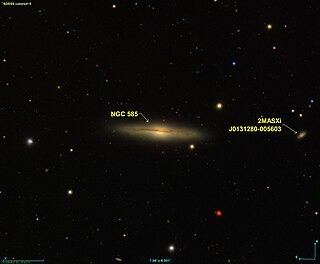
NGC 585 is a spiral galaxy in the constellation of Cetus, which is about 245 million light-years from the Milky Way's center. The object was discovered on December 20, 1827, by the British astronomer John Frederick William Herschel.




















